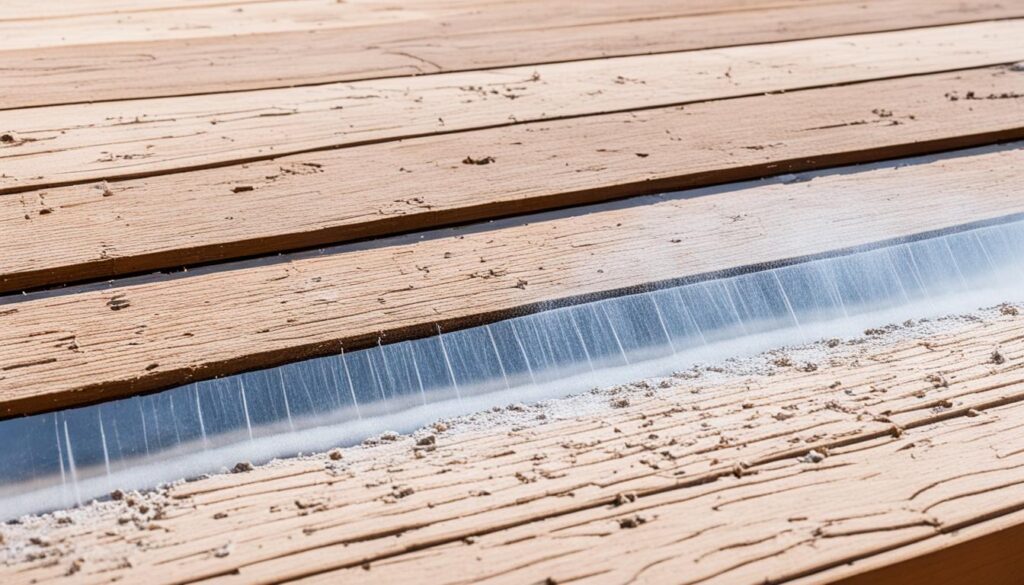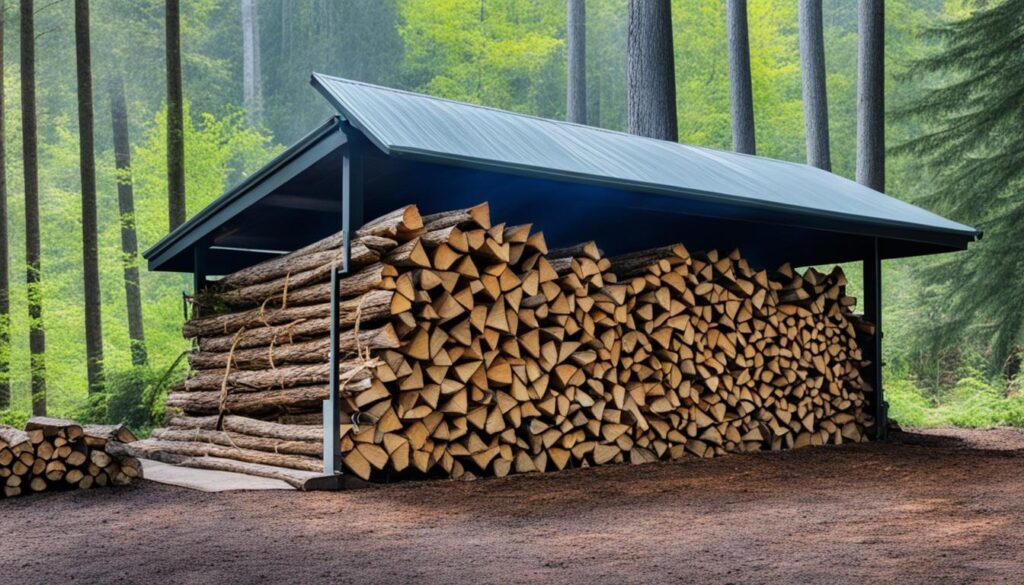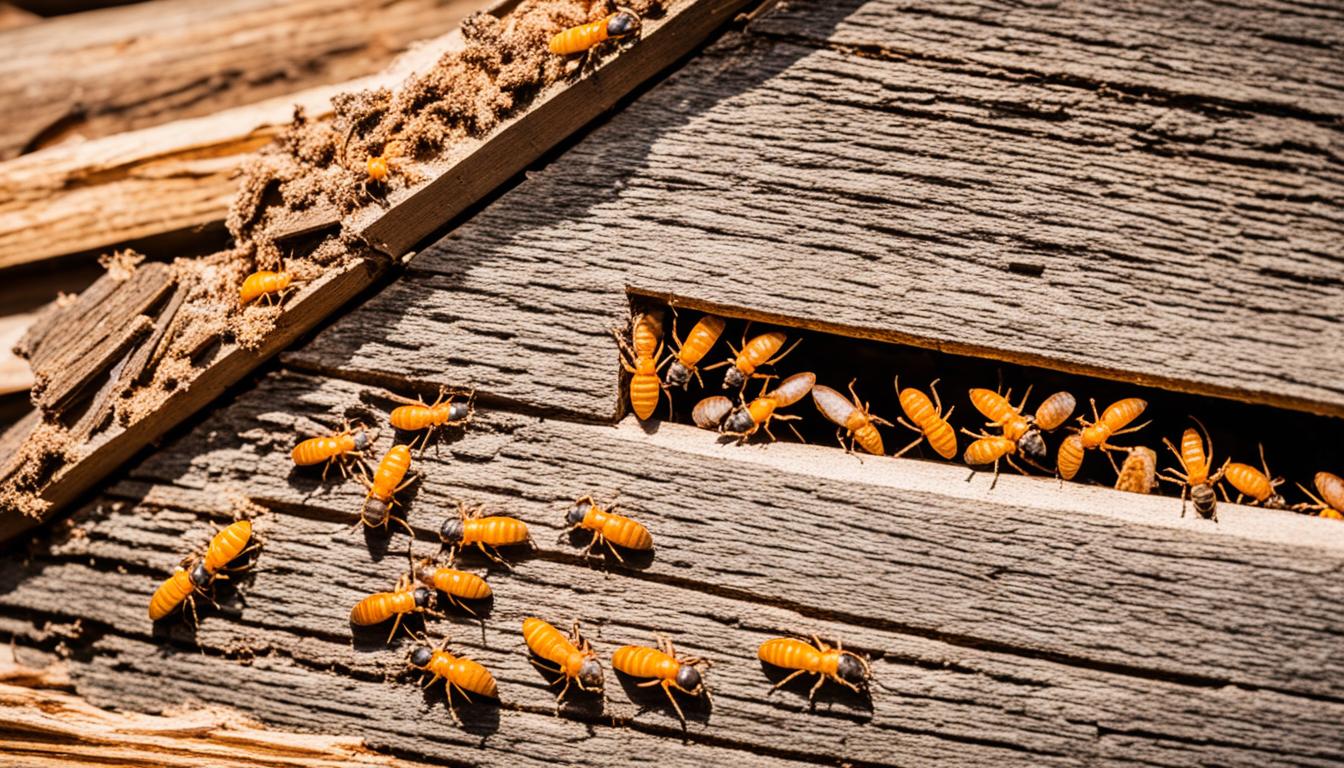Did you know termites can cost over $5 billion in home damages each year in the U.S.? Shocking, right? About 600,000 homes get invaded by them yearly. So, every homeowner should make termite prevention a top goal. We will show you the key steps to protect your home from these harm-causing insects in this guide.
Key Takeaways
- Termites can infest up to 60% of homes in areas where they are active, causing significant damage if left unchecked.
- Regular inspections and preventative treatments are crucial, as 75% of termite inspections reveal active infestations or existing damage.
- Moisture and water issues around the home can attract termites, with up to 50% of properties experiencing these problems.
- Proper sealing, wood treatment, and ventilation can help reduce the risk of termite infestations by up to 80%.
- Investing in termite prevention is far more cost-effective than dealing with the aftermath of an infestation, which can be 3-4 times more expensive.
Remove Termite Access Points
Termites can enter through a tiny 1/32-inch opening in your home. It’s vital to find and seal any spots where they might enter. As your house ages, it settles, and materials change, creating these openings. Seal cracks and gaps, fix foundation cracks, paint wood, and add bug screens to stop termites.
Seal Cracks and Gaps
Check your home for cracks around water and gas lines, doors, and windows. Use a quality caulk or foam to close these openings. This step will help keep termites out.
Patch Foundation Cracks
Foundation cracks are prime spots for termites to get in. Look closely at your home’s foundation. Use a concrete patch to fill and close any openings.
Paint Wood Surfaces
Coating wood surfaces with paint helps block termites. Focus on areas like siding and trim. The paint makes it harder for termites to access the wood beneath.
Install Bug Screens on Vents
Put bug screens over vents to keep termites out. Make sure the mesh is fine enough for termites to not pass through but allows airflow. This is crucial for avoiding termite problems.
By following these steps to seal your home against termites, you can lower the chance of dealing with a severe infestation. Protect your home from termites and the harm they bring.
Fix Leaks and Eliminate Water Sources
Termites love water and need it for survival. They use it to stay hydrated and to break down the wood they eat. You can make your home less attractive to termites by making sure gutters carry water away from the foundation and storm drains release water far from the house. Also, avoid placing sprinkler heads near the house’s base and fix leaking pipes and air conditioning. These steps will help you get rid of excess water around your home. If your home has a crawl space, think about adding dehumidifiers or barriers that block moisture. This will lower the humidity and make it hard for termites to live there.
Direct Water Away from Foundation
It’s vital to make sure water drains properly to keep termites away. Ensure gutters and downspouts lead water at least 6 feet away from the house’s base. This step helps keep the area around your home dry. A dry foundation is not attractive to termites.
Repair Leaky Pipes and AC Units
Fixing leaking pipes and air conditioning units stops water from damaging your home. It also prevents termites from finding a welcoming home in damp spots. It’s crucial to check your plumbing and AC often and fix leaks right away. This way, you’re taking big steps to remove water sources that termites like.
Use Dehumidifiers in Crawl Spaces
The moisture in crawl spaces can draw termites in. By using dehumidifiers or barriers against water, you’re making it less friendly for these pests. This method is effective in eliminating places where termites would want to be.
Eliminate Termites’ Food Sources
Termites love anything with cellulose, like wood or paper. To keep them away, remove what they eat. Here’s how:
- Remove rotting wood and dead trees from around your property. Termites love decaying things. By clearing these, you make your home less attractive to them.
- Avoid storing paper products nearby. Newspapers and boxes are a feast for termites. Keep them away.
- Use plastic containers instead of cardboard. Termites don’t like plastic. It doesn’t give them the cellulose they need.
Getting rid of termites’ food cuts your home’s risk of infestation. This simple step could save your house from their destruction.
| Statistic | Value |
|---|---|
| 90% of termite infestations are due to the presence of moisture in homes | 90% |
| Homes with leaky faucets or pipes are 50% more likely to experience termite issues | 50% |
| Keeping firewood less than 20 feet away from the house reduces the risk of termite infestation by 70% | 70% |
| Using physical barriers like stainless steel mesh decreases the likelihood of termites entering homes by 80% | 80% |
| Annual professional inspections can detect termite activity early, reducing treatment costs by 40% | 40% |
| Homes treated with borate-based wood treatments are 85% less likely to suffer termite damage | 85% |
Be proactive in stopping termites. Remove their food sources to guard your home. Remember, prevention beats dealing with a termite problem.
Protect Your Wood Deck
It’s essential to keep your wood deck in good shape for more than just looks. A well-maintained deck is less likely to attract termites. This helps it stay a safe and fun area over time.
Use Borate Treatment
Borate treatment is a great way to fend off termites. Borates are natural and safe for your deck. They create a barrier within the wood that termites don’t like. This is especially useful for decks that are older or in termite-prone places.
Maintain Deck Staining and Painting
Staining or painting your deck regularly keeps termites away. Re-doing this every two years is a good practice. It ensures the wood stays sealed, making it harder for termites to find a way in.
Prevent Water Pooling on Deck
Water pooling on the deck can lead to issues like wood rot and help termites to thrive. Don’t block drainage with planters or anything else. Also, make sure your gutters move water away. Fixing leaks fast can help stop termites too.
These proactive steps can secure your deck against termites. By staying on top of maintenance, you protect your home’s wood areas. This ensures your outdoor space lasts longer and brings peace of mind.

| Preventative Measure | Benefits |
|---|---|
| Borate Treatment | Creates an invisible barrier that repels and deters termites |
| Deck Staining and Painting | Seals the wood, preventing cracks and crevices where termites can enter |
| Preventing Water Pooling | Reduces the risk of wood rot and discourages termite infestations |
Termite Prevention Tips for Homeowners
Preventing termites is key because they can seriously harm your home. These bugs eat wood, which can be very costly to fix over time. Have a pro check your house often, keep moisture under control, treat your wood, and use the right pest control techniques. This will help keep your home safe from termites.
Maintain Regular Inspections
Getting your home checked by a pro often is crucial. Termites are hard to spot at first, but an expert can find them early. This could cost you as low as $165 for a checkup but save you a lot of cash in repairs.
Manage Moisture and Water Sources
Termites love moist areas, so fixing leaks and removing standing water is important. Repairing broken pipes and ensuring good drainage is a must. Using dehumidifiers in damp spots can also keep termites away.
Treat and Protect Wood Structures
Keeping your wood safe is a big part of fighting termites. Use treatments to protect wood above and below ground. Also, avoid letting wood touch the ground. Using termite-resistant materials for decks and fences is smart.
Utilize Professional Services
If you think you have termites, or just want to be safe, call a pest control expert. They can check your place, find problems, and give you the best ways to stop termites. Termite treatments might cost about $600, but they’re a good investment to keep your home safe.
Remember to use these tips to help avoid termites and protect your home. Being ready and taking action is your best defense against these harmful bugs.
Use Termite-Resistant Mulch
The kind of mulch you use really matters for protecting your home from termites. Some, like pine bark or softwood, can draw termites near. Yet, there are choices like cedar, melaleuca, and cypress mulches that can keep them away.
Cedar Mulch
Cedar mulch stands out for stopping termites before they get close. That’s because cedar wood has natural oils and resins that termites hate. Spread cedar mulch around your home, and you’ve got a termite-proof line they won’t cross.
Melaleuca Mulch
Melaleuca mulch or tea tree mulch is good for stopping termites and other bugs. It comes from the Melaleuca tree, which has properties that drive these pests away.
Cypress Mulch
As for cypress mulch, its heartwood has chemicals that termites don’t like. This makes it another solid defense against these insects.
Inorganic Mulches
Inorganic mulches like rocks, gravel, or shredded rubber are not food for termites. This fact alone means they are unlikely to attract these bugs.
With any mulch type, keep it away from your home’s base by 6 to 12 inches. This stops moisture and bugs from coming close. It’s also smart to look for termite signs often, like mud tubes or damaged wood, to stop problems early.
Maintain a Clean, Trimmed Yard
Lush greenery and flowers make your home look better. But they might attract termites. Follow these steps to keep your yard clean and less tempting to pests:
- Keep all bushes and shrubs at least 12 inches away from your home’s exterior walls. This makes it harder for termites to reach your home.
- Trim vegetation regularly to improve air circulation. This helps damp places dry quickly, lowering the chance of termites coming.
- Don’t plant flowers, plants, or trees directly next to the house. Instead, use planters or window boxes made from composite materials to hold your plants.
- Mow the lawn often and remove any extra grass or leaves. This takes away places for termites to hide and food to attract them.
Keeping your yard clean and neatly trimmed can discourage termites. It’s essential to prevent these destructive pests from infesting your home.
| Termite Prevention Tip | Benefit |
|---|---|
| Keep bushes and shrubs 12 inches away from home | Creates a buffer zone to prevent termite access |
| Trim vegetation regularly | Improves airflow and allows damp areas to dry faster, reducing moisture that attracts termites |
| Avoid planting directly next to the house | Eliminates potential bridges for termites to access the home’s structure |
| Regularly mow and rake the yard | Removes food sources and hiding spots for termites |
Never Store Wood Near Home
Storing firewood near your house might look convenient, but it’s a bad idea. Doing so invites termites to your home. Termites feed on wood stacks and can then target your house’s structural wood.
To protect your home, avoid keeping wood close to your foundation.
Here are some better ways to store your firewood:
- Keep wood elevated off the ground. Termites often come up from the ground. By placing your woodpile on a rack or platform, you can prevent their direct contact and access.
- Store wood several feet away from your home. A buffer zone of at least 20 feet is best. It helps keep termites away from your house.
- Inspect wood for signs of infestation before you use it indoors. Be on the lookout for mud tubes, severe wood damage, or live termites.
By following these tips, you make it harder for termites to get into your home.
| Termite Prevention Tip | Why It’s Important |
|---|---|
| Keep wood elevated off the ground | Elevating your woodpile keeps it away from soil, where termites hide. This simple step can stop them from reaching your wood. |
| Store wood several feet away from your home | Creating a gap of at least 20 feet helps in keeping your house safe. |
| Inspect wood for signs of infestation | Always check for termite warning signs in your firewood before carrying it inside. Early detection can save you a lot of trouble. |

Keep these tips in mind to keep termites out of your home. Properly storing and checking your firewood is key to preventing termite damage.
Consider Termite Bait Stations
Termite bait stations are a smart way to protect your home from subterranean termites. They locate termite activity early. This lets you solve the problem before it causes a lot of damage. Bait stations are a focused method of pest control. They use less harsh chemicals and help you keep your property safe.
Subterranean termites live in groups that can be very large. These colonies can cover up to half an acre. Using liquid barriers to stop them can mean a lot of chemicals around your home. But with bait stations, you feed the termites a bait that they take back to their nests. This can slowly eliminate the colony without lots of drilling and spraying.
Termite baits are made from wood and an insecticide that works slowly on termites. Brands like Sentricon®, Exterra®, and Trelona Advance® are used to control termite numbers. These baits are put in the ground around your home. They are placed 1-2 feet from the foundation to avoid areas already treated with chemicals.
Termites search for food in many spots, which makes it more likely they’ll find and eat the bait. In places with changing seasons, like Kentucky, termites are most active in spring and fall. That’s the best time to check on the bait stations. Success with termite baiting needs careful watching and sometimes, help from professionals.
Using termite baits helps catch termites early and controls them directly. It protects your home from serious termite damage. Acting early is key to saving your home from these bugs. It’s a great step in keeping your property safe for years to come.
| Termite Bait Station Benefits | Traditional Liquid Barrier Treatments |
|---|---|
|
|
Conclusion
It’s vital for homeowners to take a serious look at termite prevention. Doing so protects property and keeps their home’s value safe. Ways to do this include making sure termites can’t easily get in, reducing moisture, and keeping your yard neat. It’s also wise to avoid storing wood close to your house. Termite-resistant mulch, regular yard cleaning, and choosing pest control professionals are smart steps too. These actions can lower the chance of expensive termite damage.
Regular checks by a professional pest control expert are key. They spot problems early, preventing them from becoming big issues. By staying ahead in this way, house owners guard against termites’ harmful effects. This keeps their home a good investment.
Even though termites can cost a lot in damage each year, you can protect your home. With the right prevention methods and help from experts, worry fades away. This means you can relax and enjoy knowing your home is safe.
